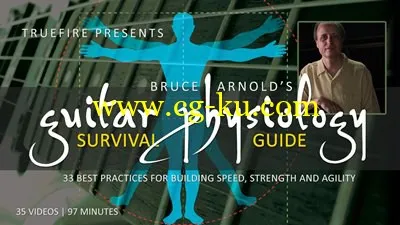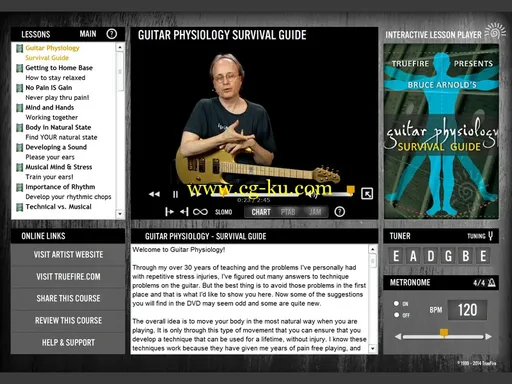
Truefire - Bruce Arnold's Guitar Physiology Survival Guide (2011)
Publisher: Truefire | Language: English
Video: MP4, data-dvd (includes Tabs), 854x480 (16:9), 775 Kbps, 29.970 fps | 796 Mb
Audio: MP3, 128 Kbps, 44100 Khz, 2 channels | Length: 01h 37min
Ask any guitarist for a wish list and you'd likely find speed, strength and fretboard agility on it along with fantastic tone and a '59 Les Paul. As we all know, the quest for perfect tone is never-ending, and the '59 can be yours if you win the lottery. But you can't buy speed, strength and agility. However, it's easier to acquire than you think with Bruce Arnold's Guitar Physiology at your fingertips.
No fancy gizmos or gadgets enclosed. No secret miracle exercises. No intervallic, string-skipping, 3-notes-per-string, speed-enhancing pyrotechnic scales to work up from 60 to 350 BPM. No kidding. Just sound advice on how to get your technique happening so you can play like a demon and do it for hours.
Bruce Arnold has been teaching guitar for thirty years. Voted "Best Teacher" in 1984 at Berklee, Arnold went on to teach at the New England Conservatory, Dartmouth and The New School. Today, he heads up guitar programs at Princeton University and New York University. He's also a monster player, composer and recording artist. Bruce knows his stuff.

"Over my many years of playing and teaching guitar, I've discovered that the key to building speed, strength and agility is HOW you play the guitar rather than WHAT you play. Of course, it's important to practice scales, various picking techniques and other exercises but if you're not holding the guitar properly or positioning your shoulders, arms, hands and fingers properly then you will NEVER achieve the speed, strength and agility you desire. It's simply not physically possible. In fact, if you don't develop a solid foundation of physical and functional techniques, you'll likely expereience repetitive stress injuries."
Arnold suffered more than his fair share of stress injuries and spent many years working with physical therapists recuperating from those injuries and more importantly, learning how to prevent them. Modifying specific physical aspects of his playing not only eliminated his pain, it significantly enhanced his technique and stamina. Garnered from personal experience and then further honed as he shared his techniques with hundreds of his students, Arnold's Guitar Physiology now presents all of his best practices for HOW to play the guitar.
"The overall idea is to move and position your body, arms, hands and fingers in the most natural way when you're playing and practicing. It is only through this type of movement that you can develop a technique that can be used for a lifetime, without injury. I know these techniques work because hundreds of my students have also developed phenomenal technical ability and today enjoy very fruitful careers in music with little or no physical problems."
Guitar Physiology Syllabus:
Getting to Home Base
No Pain IS Gain
Mind and Hands
Body in Natural State
Developing a Sound
Musical Mind & Stress
Importance of Rhythm
Technical vs. Musical
Physical Position
Guitar Placement
Best Straps and Guitars
Left-Hand Techniques 1
Left-Hand Techniques 2
Left-Hand Fingertips 1
Left-Hand Fingertips 2
Fingertip Pressure
Left-Hand Thumb Position
Positioning Left-Hand Wrist
Palm of Left-Hand
Elbow of Left Arm
Left Shoulder Considerations
Holding the Pick: Again, keep it relaxed!
Picking Considerations 1: Don't pick deep!
Picking Considerations 2: Don't pick too wide!
Picking Considerations 3: Keep a consistent attack!
Right-Hand Position: Keep it close and loose!
Right-Hand Wrist: Float freely but steadily!

Right Forearm: The initiator of movement!
Right Forearm Exercises: The EKG Method
Forearm Development: More Forearm Studies
The Right Elbow: Slight to NO movement!
The Right Shoulder: Keep it relaxed!
Please be advised, Bruce Arnold's Guitar
Physiology is NOT a medical guide of any kind nor is it a substitute for therapy if you're already experiencing stress injury. See a specialist!
Guitar Physiology is also no quick fix. Depending on how long you've been playing, you will likely need to re-learn many of the physical qualities that you don't even think about anymore; how you hold and use the pick, where you position your elbows or forearms, the angle of your wrists, the positioning of your finger in relationship to the strings, even how you strap on a guitar -- it's all critical.
Arnold recommends that you only try to modify or re-learn one element of your playing at a time and so the process may be a lengthy one as you develop new playing habits and muscle memory. Take your time and Guitar Physiology will indeed deliver the speed, strength and agility you wish for.